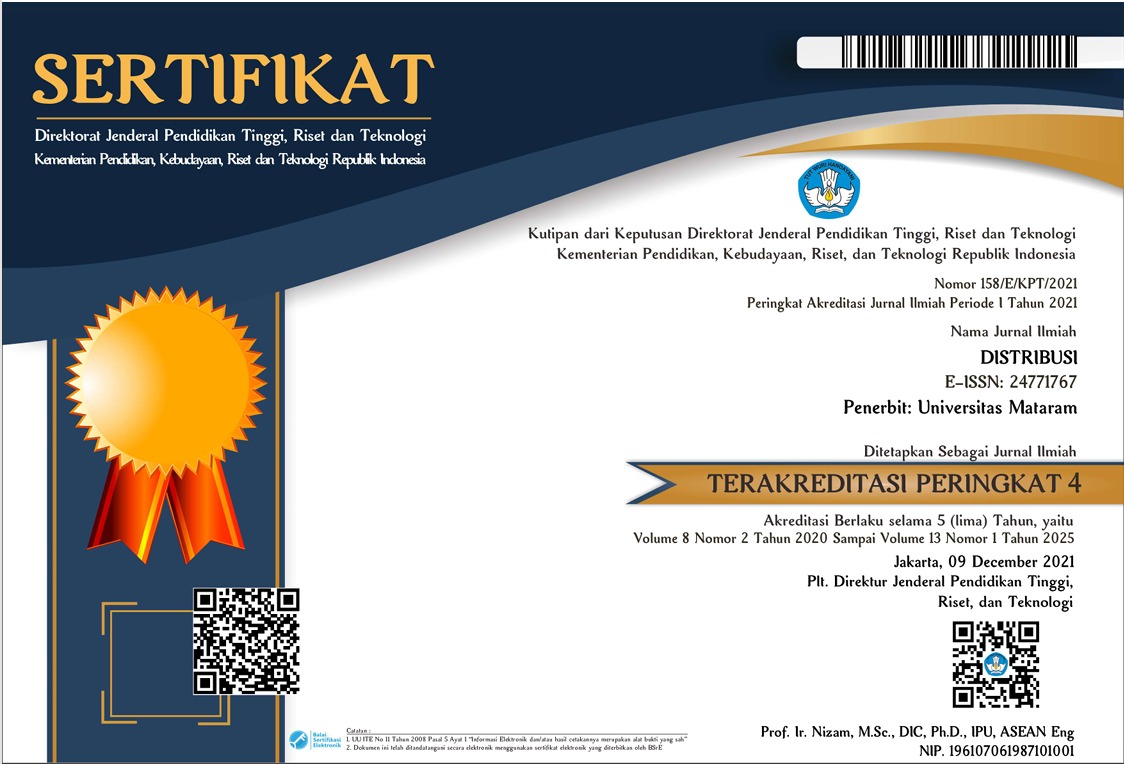SUCCESS AND FAILURE FACTORS OF THE IMPLEMENTATION OF COMPUTER BASED INFORMATION SYSTEMS IN THE GOVERNMENT INSTITUTIONS OF MATARAM CITY: INFORMATION SYSTEM RESOURCE PERSPECTIVE
DOI:
https://doi.org/10.29303/distribusi.v8i1.97Keywords:
software, networking and procedures, hardware, human resources, information resourcesAbstract
The purposes of this study were to identify the factors of success and failure of the implementation of computer-based information systems at the Departments of Government in the city of Mataram, and to determine the position or to map the information system, information resources’ perspectives. This research is a descriptive study by collecting primary data from 32 government agencies which was based on interviews based on the questionnaire that has been prepared. The results showed that the persistence of the mismatch of education and skills resource officers from the perspective of human information. Inadequate readiness of the hardware owned by the Government Agencies. Most of operating systems (OS) used and Microsoft Windows-based applications are still vulnerable to a computer virus attacks. SOP is not owned by most of the Government Agencies, and the some have still not complied. The computer networking is still underdeveloped in most of the Government Agencies. Finally, the data or information has not been fully utilized by almost all levels of management to the decision-making process. To that end, it is suggested that it is necessary to strengthen and empowering capabilities and expertise personnel, upgrading and server procurement, the development of wireless-based network for the short term, while maintaining a commitment at all levels of management to utilize the data/ information in the decision-making process
Downloads
References
Abdelsalam, H., Reddick, C. G., & Elkadi, H. (2012). Success and Failure of Local e-Government Projects: Lessons Learned from Egypt. Cairo, Egypt: Cairo University.
Abduh, A. (2015). Laporan Keterangan Pertanggungjawaban Akhir Masa Jabatan Walikota Mataram Periode 2010-2015. Mataram: Kota Mataram.
Akcam, B. K., Guclu, A. N., Guler, A., Hekim, H., & Ogune, G. (2012). Critical Success Factors of IT Enabled Organization Change in Hierarchical Government Organizations: LIAS Case. International Journal of Economics and Management Science, 2(1), 25-35.
Al-Azri, A., Al-Salti, Z., & Al-Karaghouli, W. (2010). The Successful Implementation of E-Government Transformation: A Case Study in Oman. European, Mediterranean & Middle Eastern Conference on Information Systems.
Alhomod, S., & Shafi, M. M. (2013). Success Factors of e-Learning Projects: A Technical Perspective. The Turkish Online Journal of Educational Technology, 12(2).
Almajed, A. I., & Mayhew, P. (2013). An Investigation of the Critical Success Factors of IT Projects in Saudi Arabian Public Organizations. IBIMA Business Review, 2013(1), 10.
Buchwald, C. C. (1997). Canadian University Policy and the Information Infrastructure: Past Lessons, Future Directions. Canadian Journal of Communication, 22(2).
Cauter, L. V., Snoeck, M., & Crompvoets, J. (2013). Public Administration Meets Information System Research: Analysing Failures of Intergovernmental Information Systems Via IS Success Models. Belgium: KU Leuven, Public Government Institute.
Elpez, I., & Fink, D. (2006). Information Systems Success in the Public Sector: Stakeholders' Perspectives and Emerging Aligmnet Model. Issues in Informing Science and Information Technology, 3(1).
Hastie, S. (2006). What Makes Information Systems Projects Successful? Software Education. Wellington: Victoria University.
JAL, S. (2008). IT Project Benchmarking: Project Success Criteria Analysis. Canada: CATA.
Kaur, B. P., & Aggrawal, H. (2013). Critical Failure Factors in Information System: An Exploratory Review. Journal of Global Research in Computer Science, 4(1).
Napitupulu, D., & Sensuse, D. I. (2014). The Critical Success Factors Study for e-Government Implementation. International Journal of Computer Applications, 89(16).
Nawi, H. S. A., Rahman, A. A., & Ibrahim, O. (2012). Government ICT Procject Failure Factors: Project Stakeholders' Views. Journal of International Systems Research and Innovation.
Poon, P., & Wagner, C. (2001). Critical Success Factors Revisited: Success and Failure Cases of Information Systems for Senior Executives. Decision Support Systems, 30, 393-418.
Raymond McLeod, J. (2004). Sistem Informasi Manajemen (8 ed.). Jakarta: PT. Indeks.
Shin, S., Song, H., & Kang, M. (2008). Implementing e-Government in Developing Countries: Its Unique and Common Success Factors. Bangkok: Ewha Women's University.
Sirma, J., Obegi, F., & Ngacho, C. (2014). An Analysis of Factors Influencing Implementation of Computer Based Information Systems in Public Universities in Kenya: A Case Study of Egerton University. Information and Knowledge Management, 4(8).
Vaughan, P. J. (2003). System Implementation Success Factors: It's not just the Technology. Boulder, Colorado: University of Colorado.
Ziemba, E., & Oblak, I. (2013). Critical Success Factors for ERP Systems Implementation in Public Administration. Interdisciplinary of Information, Knowledge, and Management, 8(1).
Downloads
Published
How to Cite
Issue
Section
License
Copyright (c) 2020 Budi Santoso, Emilia Septiani

This work is licensed under a Creative Commons Attribution-ShareAlike 4.0 International License.
Penulis yang naskahnya diterbitkan menyetujui ketentuan sebagai berikut:
- Hak publikasi atas semua materi naskah jurnal yang diterbitkan/dipublikasikan dalam situs Jurnal DISTRIBUSI ini dipegang oleh dewan redaksi dengan sepengetahuan penulis (hak moral tetap milik penulis naskah).
- Ketentuan legal formal untuk akses artikel digital jurnal elektronik ini tunduk pada ketentuan lisensi Creative Commons Attribution-ShareAlike (CC BY-SA), yang berarti Jurnal DISTRIBUSI berhak menyimpan, mengalih media/format-kan, mengelola dalam bentuk pangkalan data (database), merawat, dan mempublikasikan artikel tanpa meminta izin dari Penulis selama tetap mencantumkan nama Penulis sebagai pemilik Hak Cipta.
- Naskah yang diterbitkan/dipublikasikan secara cetak dan elektronik bersifat open access untuk tujuan pendidikan, penelitian, dan perpustakaan. Selain tujuan tersebut, dewan redaksi tidak bertanggung jawab atas pelanggaran terhadap hukum hak cipta.









